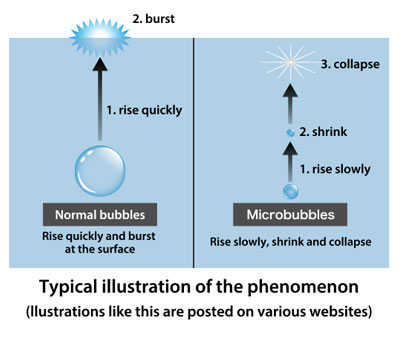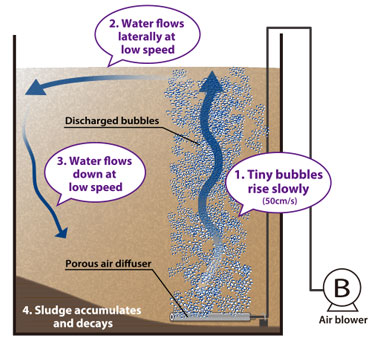[Microbubble] Is “microbubble self-collapse” a real phenomenon?
Is there such a thing as "microbubble self-collapse”?
When microbubbles are made, do they really "self-collapse"?

Most of the inquiries we receive are from customers who have read about "self-collapsing microbubbles" and have high expectations. Searching for "microbubbles" or "fine bubbles" returns numerous pages that describe this phenomenon as if it were real. Many manufacturers of microbubble generators claim this in their advertising. This claim has its origins in a paper published by a Japanese researcher, and is often explained with illustrations similar to those on the right. According to the researcher, "When microbubbles with a diameter of 50 μm or less are created in water, the microbubbles shrink due to increased pressure caused by surface tension. Eventually, the pressure inside the bubbles becomes infinitely high, creating a region of high temperature and pressure, along with free radicals”.
Based on this, microbubble generator companies make claims in their advertising such as "generating microbubbles also generates virus-killing free radicals" and "wastewater can be treated solely using microbubbles because they decompose organic matter". This research was widely believed as, at the time of publication, its author belonged to a prestigious national research institute.
This phenomenon has not been independently verified
It is claimed only by a minority
If this phenomenon were real, papers on unprecedented chemical reaction methods harnessing its enormous energy would surely be published all over the world. In reality, however, no such research exists. Moreover, the results of the original paper have not been replicated.
Regarding this phenomenon, Professor Emeritus Akira Serizawa of Kyoto University has made the following comments:
- This phenomenon is not consistent with the laws of physics.
- Microbubbles do not automatically shrink and collapse.
- If it were true that microbubbles in water automatically shrink and collapse, the shock waves would synergistically amplify each other, creating very high energies that would raise the water temperature. In reality, no such temperature rise occurs.
Bubble collapse has been observed in the field of sonochemistry
However, the methods are entirely different
In sonochemistry, ultrasound can be used to induce bubble collapse (not self-collapse), but this phenomenon is entirely different from the aforedescribed false notion that microbubbles shrink by themselves.
 When a liquid is irradiated with high-energy ultrasound, dissolved gas collects in areas of negative pressure, creating so-called cavitation bubbles. By continuing to irradiate the bubble, it gradually grows larger while undergoing repeated contraction and expansion. Once the cavitation bubble reaches around 150 microns in diameter, it can no longer maintain its shape under the external pressure. Liquid then penetrates the bubble, causing it to collapse. This moment is captured in the microscope image to the right.
When a liquid is irradiated with high-energy ultrasound, dissolved gas collects in areas of negative pressure, creating so-called cavitation bubbles. By continuing to irradiate the bubble, it gradually grows larger while undergoing repeated contraction and expansion. Once the cavitation bubble reaches around 150 microns in diameter, it can no longer maintain its shape under the external pressure. Liquid then penetrates the bubble, causing it to collapse. This moment is captured in the microscope image to the right.
At this point, the cavitation bubble reaches an internal temperature of around 5,500°C, comparable to the surface of the Sun, and releases a jet of liquid at 400 km/h. Light is also emitted at the same time.
The ISO standard stipulates that fine bubbles are those below 100 μm in diameter, while microbubbles are between 1.0 and 100 μm. The 150 μm bubble mentioned above is neither of these. And because it continues to receive energy in the form of ultrasonic waves, this large bubble swells to its maximum stable size before suddenly collapsing and releasing enormous amounts of stored energy.
The high-energy shock waves released when cavitation bubbles collapse are a well-known cause of wear to ship propellers and pump impellers. These propellers and impellers rotate at high speed in water, creating localized regions of negative pressure that form cavitation bubbles of dissolved gas. These bubbles then collapse close to the propeller or impeller, creating shock waves that cause surface erosion and abnormal vibrations. The photo to the right shows an impeller with a cavitation hole.
Bubbles can also be made to collapse intentionally using ultrasound in order to harness the enormous energies for chemical reactions.
Were microbubbles to collapse naturally, DAF systems would not function
It is our position that the idea of natural microbubble collapse is clearly erroneous. A water treatment method called DAF (dissolved air flotation), in which microbubbles attach to solids and float them to the surface, has been in large-scale worldwide use for an extremely long time. There have been no reports of a mysterious phenomenon that allows organic matter (BOD or COD) to be decomposed solely using microbubbles. Moreover, if the microbubbles collapsed and disappeared, DAF would not be possible in the first place.
As an example of an attempt to verify the phenomenon of self-collapsing microbubbles, engineers from Oji Paper Co., Ltd published a paper entitled "Application of micro bubble treatment technology to paper-making effluent treatment", which found that organic matter in wastewater remained undecomposed after microbubble treatment. Below is a summary of their findings.
The former national institute researcher discussed in the first section bears a heavy responsibility for disseminating false information and causing confusion throughout the industry.
The ideal bubble size varies
There is a recent trend in the fine bubble industry to assert that smaller is always better. For example, some companies advertise that they can create water containing tens of thousands of ultrafine bubbles per 1 mL.
However, as previously discussed, the bubbles that undergo sonochemical collapse are approximately 150 μm across, and therefore fall outside the category of fine bubbles. Hence the assumption that "smaller bubbles are always better" is completely preposterous.

Consider the case of air diffusers, which dissolve oxygen into and prevent sludge accumulation in wastewater that contains a large amount of microorganisms. The most popular type of air diffuser, the porous diffuser, discharges minute bubbles several centimeters in diameter in order to achieve a larger contact area. However, tiny bubbles have a low specific gravity and therefore rise slowly, causing sludge sedimentation and oxygen deficiency. Effective aeration cannot be achieved without coarse bubbles, which have a powerful churning effect on the whole tank.
Recently, some companies have recommended using a microbubble generator instead of an air diffuser. This is absolutely not an alternative. For details, please see the link below.
Rubber porous diffusers are not suitable for industrial wastewater












